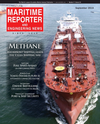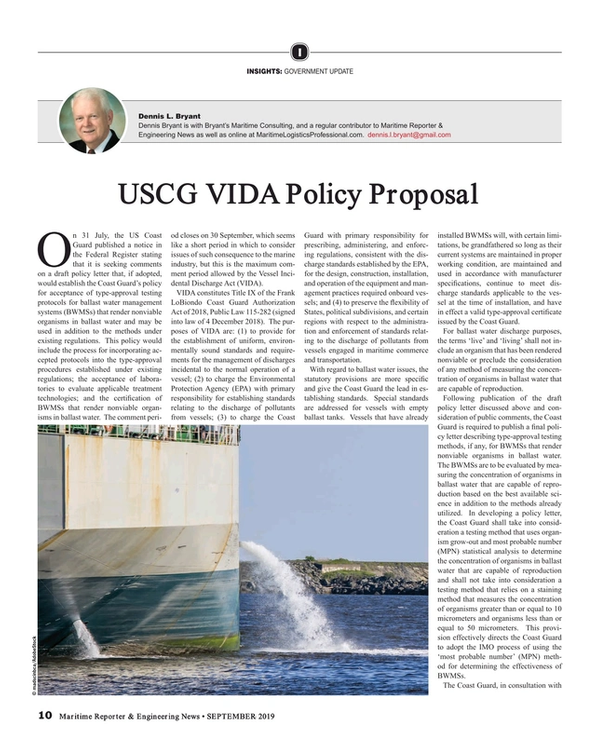
USCG VIDA policy proposal
On 31 July, the US Coast Guard published a notice in the Federal Register stating that it is seeking comments on a draft policy letter that, if adopted, would establish the Coast Guard’s policy for acceptance of type-approval testing protocols for ballast water management systems (BWMSs) that render nonviable organisms in ballast water and may be used in addition to the methods under existing regulations. This policy would include the process for incorporating accepted protocols into the type-approval procedures established under existing regulations; the acceptance of laboratories to evaluate applicable treatment technologies; and the certification of BWMSs that render nonviable organisms in ballast water. The comment period closes on 30 September, which seems like a short period in which to consider issues of such consequence to the marine industry, but this is the maximum comment period allowed by the Vessel Incidental Discharge Act (VIDA).
VIDA constitutes Title IX of the Frank LoBiondo Coast Guard Authorization Act of 2018, Public Law 115-282 (signed into law of 4 December 2018).
The purposes of VIDA are: (1) to provide for the establishment of uniform, environmentally sound standards and requirements for the management of discharges incidental to the normal operation of a vessel; (2) to charge the Environmental Protection Agency (EPA) with primary responsibility for establishing standards relating to the discharge of pollutants from vessels; (3) to charge the Coast Guard with primary responsibility for prescribing, administering, and enforcing regulations, consistent with the discharge standards established by the EPA, for the design, construction, installation, and operation of the equipment and management practices required onboard vessels; and (4) to preserve the flexibility of States, political subdivisions, and certain regions with respect to the administration and enforcement of standards relating to the discharge of pollutants from vessels engaged in maritime commerce and transportation.
With regard to ballast water issues, the statutory provisions are more specific and give the Coast Guard the lead in establishing standards. Special standards are addressed for vessels with empty ballast tanks. Vessels that have already installed BWMSs will, with certain limitations, be grandfathered so long as their current systems are maintained in proper working condition, are maintained and used in accordance with manufacturer specifications, continue to meet discharge standards applicable to the vessel at the time of installation, and have in effect a valid type-approval certificate issued by the Coast Guard. For ballast water discharge purposes, the terms ‘live’ and ‘living’ shall not include an organism that has been rendered nonviable or preclude the consideration of any method of measuring the concentration of organisms in ballast water that are capable of reproduction.
Following publication of the draft policy letter discussed above and consideration of public comments, the Coast Guard is required to publish a final policy letter describing type-approval testing methods, if any, for BWMSs that render nonviable organisms in ballast water. The BWMSs are to be evaluated by measuring the concentration of organisms in ballast water that are capable of reproduction based on the best available science in addition to the methods already utilized. In developing a policy letter, the Coast Guard shall take into consideration a testing method that uses organism grow-out and most probable number (MPN) statistical analysis to determine the concentration of organisms in ballast water that are capable of reproduction and shall not take into consideration a testing method that relies on a staining method that measures the concentration of organisms greater than or equal to 10 micrometers and organisms less than or equal to 50 micrometers. This provision effectively directs the Coast Guard to adopt the IMO process of using the ‘most probable number’ (MPN) method for determining the effectiveness of BWMSs.
The Coast Guard, in consultation with the EPA and in coordination with the Aquatic Nuisance Species Task Force, is also charged with establishing a framework for federal and intergovernmental response to aquatic nuisance species risks from discharges from vessels, including the introduction, spread, and establishment of such populations.
The draft policy letter, and eventually the final policy letter, apply only to testing protocols for BWMSs that render nonviable (as defined in VIDA) organisms in ballast water. Testing protocols accepted under the policy letter that render organisms in ballast water nonviable based on the best available science may be substituted for methods identified in current protocols. The draft policy letter states that Coast Guard does not currently know of any type-approval testing protocols for BWMSs that render nonviable organisms in ballast water that are based on best available science.
This particular statement in the draft policy letter is curious since the IMO and the vast majority of the maritime community (other than the USCG and the EPA) accept the MPN method as one of the best available scientific methods for determining the efficacy of BWMSs. The purpose of the policy letter is to establish the process be used by the Coast Guard for accepting type-approval testing protocols.
The instructions for submitting testing protocols are extensive and specific. It is beyond my limited range of knowledge and experience to comment on those instructions, other than to note the confusion engendered by the apparent contradiction between the VIDA-directed approach toward MPN
and the apparent reluctance of the Coast Guard to adopt the MPN protocol into its official policy.
I do, though, propose an addition to the current policy that will improve the transparency of BWMS type-approval testing protocol. It is important that the playing field between the various accepted independent laboratories (ILs) be as level as possible. This is necessary so that a BWMS preliminarily approved or disapproved by one IL be highly likely to achieve the same result from any other of the accepted ILs. One way to maintain this level playing field is to prohibit ex parte communications between the Coast Guard and one or only some of the accepted ILs. Communications from one IL to the Coast Guard must be shared with all other accepted ILs. Likewise, all communications from the Coast Guard on this issue must be shared with all of the accepted ILs. The process must not only be fair, it must be seen as fair by all stakeholders and the public.
The changes to the US ballast water management system regime promise common-sense reform and improved international consistency. Hopefully, the Coast Guard can implement these changes in a smooth, logical, and open process.
Read USCG VIDA policy proposal in Pdf, Flash or Html5 edition of September 2019 Maritime Reporter
Other stories from September 2019 issue
Content
- Training Tips for Ships: Never Give the Same Exam Twice page: 8
- USCG VIDA policy proposal page: 10
- Small Scale FSRU: Think Smarter Not Bigger page: 12
- AIS Provide Skidmarks on the Ocean page: 16
- Cyber Hack: Fortifying Maritime, Port Security page: 20
- Interview: Davide Breviglieri, CEO of Azimut Yachts do Brasil page: 22
- "Green" Ammonia's Future as a Marine Fuel page: 32
- Interview: Martin Kits van Heyningen, CEO, KVH page: 36
- Interview: Tore Morten Olsen, President Maritime, Marlink page: 41


